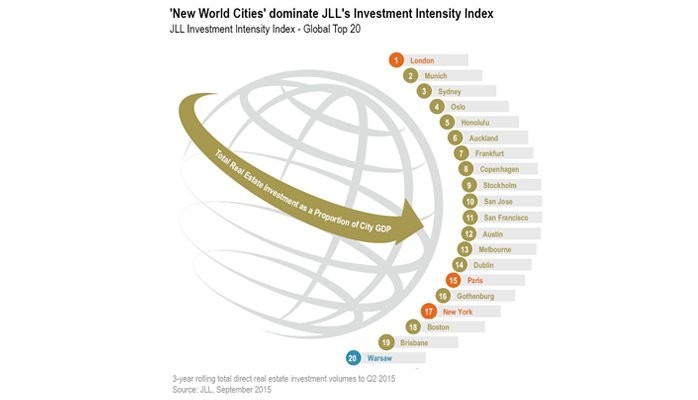
Welcome to the New World of Cities
The size, shape and character of the world’s cities are changing. The traditional concept of a global city hierarchy is shifting to a model of city clusters and systems:
- ‘New World Cities’ are attracting corporations, talent and a disproportionate share of investment capital, re-defining what it means to be global.
- ‘Emerging World Cities’ are on a fast track to maturity.
- ‘Established World Cities’ remain dominant commercially but face new competition and challenges.
Globalization, urbanization and technology – plus a deeper understanding of what makes cities competitive and attractive to both individuals and corporations – are changing the urban commercial landscape. In ‘Globalization and Competition: The New World of Cities”, a new research report JLL has completed in partnership with The Business of Cities, we divide cities into three broad categories to investigate the implications of this change.
New World Cities are redefining the meaning of global. They tend to be mid-sized and highly liveable, with strong technology credentials and up-to-date infrastructure. Vancouver, Munich and Brisbane are examples, and with other New World Cities, they are attracting talent, corporations and a disproportionate share of real estate investment globally. Their share of global investment has virtually doubled from 11% in 2006 to 19% today. As they create urban development models which are smart, sustainable and resilient, our researchers predict that they will be in the vanguard of innovation in real estate and life- and work-styles. They are often the home of millennials, a group that favors less traditional real estate, preferring character-filled properties in vibrant, mixed-use neighborhoods. In these cities, real estate will play a key role in building alliances between businesses, universities and other contributors to the urban experience.
Emerging World Cities are breaking from the pack. Given their long-term growth opportunities, they are attracting increasing levels of real estate activity. But the rise of these cities is uneven. Shanghai, Beijing, Istanbul, Taipei and Kuala Lumpur are maturing relatively quickly, but others are finding it difficult to keep up with the pace of change. Many emerging cities are seeing massive expansion through ambitious mixed-use schemes and trophy developments. But the category also includes some the world’s most environmentally challenged cities, where real estate can be a driver of more sustainable urban models.
Established World Cities are maintaining their dominance, most notably the ‘Big Six’: New York, Tokyo, London, Paris, Hong Kong and Singapore. But they will need to execute ambitious urban transformation projects, like the ‘Grand Paris’ redevelopment, to accommodate new growth and protect their global competitiveness. The ‘Big Six’ could become the ‘Big Ten’ over the next few years as Seoul, Sydney, Toronto and Shanghai acquire the characteristics of the Established World Cities.
These three categories are neither static nor mutually exclusive. Cities like Dubai, Bangalore and Shenzhen share many characteristics of Emerging Cities, but also display the agility of New World Cities. As a result, our researchers believe they are cities to watch.
Much attention has been devoted to how individual cities are dealing with serious demands that are redefining the competitive framework between cities around the world: strained infrastructure, tight funding, suboptimal land use, and a lack of clear future strategy. What is becoming increasingly apparent is that city styles, objectives and capabilities are also being redefined, altering the nature of the traditional city hierarchy. No longer does size alone determine growth, or industrial profile drive success, or history define attractiveness. As our report indicates, cities seeking competitive advantage today are describing and developing themselves in ways that speak to new and distinct purposes and intentions.
You will find the full ‘Globalization and Competition: The New World of Cities”, report here.
Visit the Business of Cities Ltd website here.

Tecno Brand Enthusiast/ Business Development Professional/Connector/Problem Solver/Seeker
8yInteresting that Atlanta was not mentioned here given it's corporate growth and airport size.
22LIGHT - M&A
8yGreat acumen on precise listing on global cities. Thanks for the share. Article on emerging market mortage rates vs developed mortage rates would be an interesting in building a global real estate investment portfolio appealing to investors. The effect of Forex changes would make the analysis real time.
Realtor at EXP Realty, LLC
8yWould like to see Santiago, Chile as one of best in Latin America.
English Teacher at Freelancer (self employed)
8yinteresting article
Portfolio Manager, CIBC Asset Management
8yVery interesting article, and nice to see Canadian cities registering as so relevant.